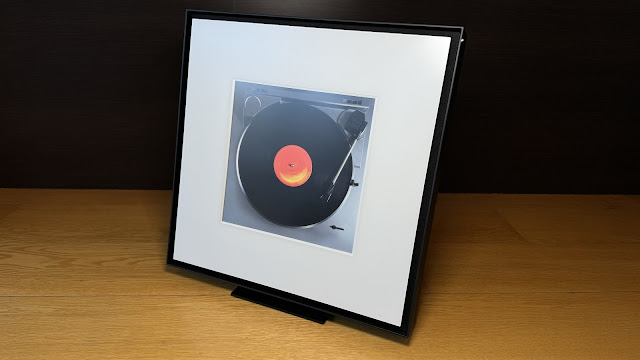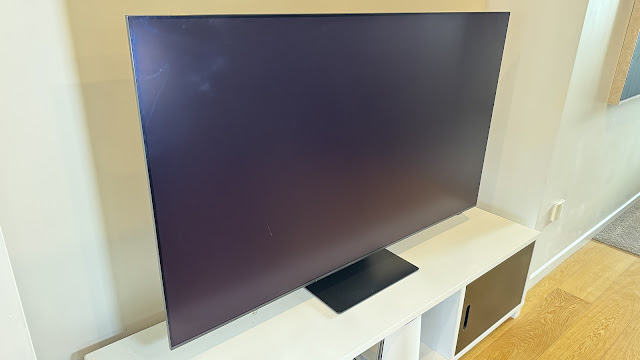These days it's rare to witness a truly original idea in tech.
Or at least, sometimes it seems the moment somebody has one, everybody else is doing it too.
That's why I was so surprised to see Samsung's Frame TVs go virtually unchallenged in the marketplace until just this year.
By recognising the fact that not everyone thinks having a huge telly as the centrepiece of their living room is the height of interior decor, Samsung cornered the market in TVs that don't look like TVs.
The key here, of course, was that while it was a simple idea, it was also expertly executed.
The Frame TV has been popular, especially in New Zealand, not just because it can look like a piece of art when you're not using it but also because it's a really great, full-featured TV when you are.
But this is not a TV review.
 The Music Frame also looks like a picture in a frame. But in this case, that's because it is.
The Music Frame also looks like a picture in a frame. But in this case, that's because it is.
The piece of art on display is not a screen... it's an actual piece of art. Each music Frame comes with a couple of choices in the box but of course there's nothing stopping you using your own. The front panel simply pulls off revealing a high quality, reusable matte with a sturdy backing that allows you to slide different pictures in and out. There are also corner mounts included in the box that can be affixed to a larger "Art Panel" - this displays artworks 13-inches by 13-inches without a matte around the edges - although I don't seem to be able to find a local supplier for this option.
But let's not get distracted, because, just like the Frame TV, the Music Frame is not really about the art - whatever you decide that to be. This is also a bloody good speaker.
 It comes with both a substantial stand and an equally robust wall-mount in the box. That's because it's quite heavy - 4.6kg to be exact. Now I don't know about you but in my experience, a heavy speaker often means a quality speaker. A solid build is more likely to accomodate a big, rich, powerful sound with less chance of distortion or rattle. That certainly seems to be the case here.
It comes with both a substantial stand and an equally robust wall-mount in the box. That's because it's quite heavy - 4.6kg to be exact. Now I don't know about you but in my experience, a heavy speaker often means a quality speaker. A solid build is more likely to accomodate a big, rich, powerful sound with less chance of distortion or rattle. That certainly seems to be the case here.
Setup is through the Samsung SmartThings app, where you can connect it to your Wi-Fi network, update the firmware and link with your Amazon Alexa and Spotify accounts. Oddly, you don't seem to be able to link any other streaming services directly - not even Amazon Music, which seems strange given you can use Alexa to control the device.
 That being said, you can connect a source device any number of ways; bluetooth, Apple Airplay or even as a Google Chromecast.
That being said, you can connect a source device any number of ways; bluetooth, Apple Airplay or even as a Google Chromecast.
It's all a bit overwhelming actually - as are the settings available on the SmartThings app. You can adjust the EQ to your preference but then there's a Sound Mode option, with the choices of Standard, Music or Adaptive Sound+. Oh, and there's also a SpaceFit toggle. How could I forget that?
 The problem - and I guess it's a nice problem to have - is there's just so many ways to use this speaker.
The problem - and I guess it's a nice problem to have - is there's just so many ways to use this speaker.
Including pairing it with your TV.
Believe it or not, because the Music Frame is so powerful and has excellent bass response, it's actually not a half bad soundbar - although with no HDMI port you only have the option to connect wirelessly or via optical cable. But if you want real magic, grab yourself a late model Samsung TV with the Q-Symphony feature.
I talked a bit about this in last week's Samsung S95D OLED review; Q-Symphony lets you add any combination of Samsung speakers, soundbars and subwoofers to the TV's own, built-in speaker system to create the ultimate, surround-sound home theatre listening experience. This isn't just room-filling audio, it'll reach absolutely every corner.
That's where the aforementioned features like Adaptive Sound+ and SpaceFit really come into their own, intelligently analysing the content being played and matching it to the room it's being played in.
 And you don't need to be watching a Marvel blockbuster to appreciate it. Right now I've grouped two Music Frames together and I'm listening to the live version of John Mayer's "Why, Georgia." The effect of this expertly performed and recorded track played through these speakers instantly transports me to the Nokia Theatre, L.A. in 2007. The space, the crowd, the live feel - all reproduced exquisitely.
And you don't need to be watching a Marvel blockbuster to appreciate it. Right now I've grouped two Music Frames together and I'm listening to the live version of John Mayer's "Why, Georgia." The effect of this expertly performed and recorded track played through these speakers instantly transports me to the Nokia Theatre, L.A. in 2007. The space, the crowd, the live feel - all reproduced exquisitely.
Oddly, grouping two Music Frames together like this doesn't create a stereo pair, yet when you add them to a Samsung TV's Q-Symphony setup, you can designate them left and right or even use them as rear surrounds.
At their initial NZ$750 asking price, that would have added up to a fairly extravagant home stereo but the Music Frame is currently available on the Samsung website for just NZ$479 - which I consider a bargain considering what it's capable of.
See? So many ways to enjoy this speaker. And it doesn't even look like a speaker.
If you love your Frame TV because of its ability to morph into a beautiful piece of art, pairing it with a couple of Music Frames seems like a bit of a no-brainer.




































